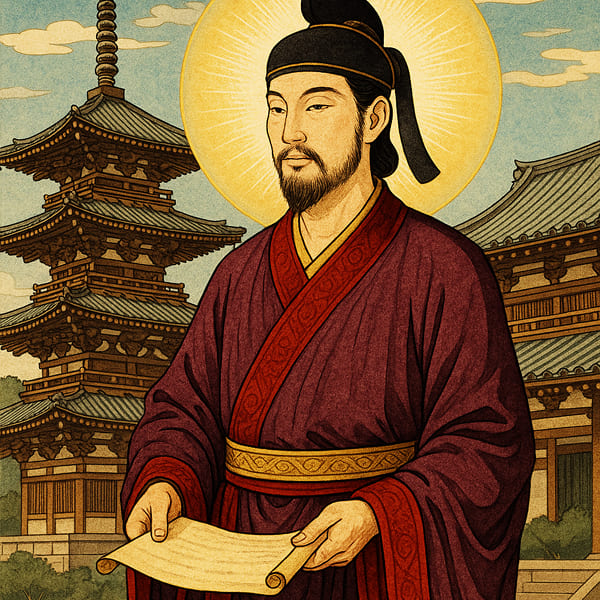Prince Shōtoku: The Mythical Guardian of Buddhism and Japan’s Spiritual Heritage

Contents
Was he a brilliant prince, a visionary reformer—or a divine being sent to shape Japan’s spiritual destiny?
Prince Shōtoku (Shōtoku Taishi, 聖徳太子) stands as one of Japan’s most iconic and mysterious historical figures. Celebrated for introducing Buddhism, crafting a visionary constitution, and advancing ethical governance, his legacy goes far beyond politics. Across the centuries, legends and sacred tales have transformed him into a spiritual icon, said to possess divine origins and miraculous powers.
In this article, we uncover the mythical side of Prince Shōtoku—from his radiant birth and healing abilities to his deification as a guardian of Buddhism. Discover how history and folklore merge in the story of a prince who became more than a man: a symbol of Japan’s cultural and spiritual identity.
A Divine Birth: The Heavenly Arrival of Prince Shōtoku
Legends describe the birth of Prince Shōtoku as a divine event. A rainbow appeared in the sky, the land flourished with abundance, and a radiant light shone on the newborn’s face—signs that he was no ordinary child. These miraculous elements suggested that he was born as a divine messenger, destined to fulfill a sacred role in Japan's spiritual evolution.
The Seventeen-Article Constitution: A Fusion of Governance and Buddhist Morality
One of Shōtoku’s most influential accomplishments was the creation of the Seventeen-Article Constitution (Jūshichijō Kenpō). This document integrated Buddhist and Confucian values into Japan’s political framework, emphasizing harmony, morality, and respect. Although not a religious text, it laid the groundwork for ethical leadership and reflected the prince’s vision of a just society guided by spiritual principles.
Patron and Protector of Buddhism: From Statesman to Sacred Figure
Prince Shōtoku was instrumental in spreading Buddhism throughout Japan. His unwavering devotion earned him posthumous deification as a guardian of the faith. Temples and shrines were built in his honor, where he was worshipped as a spiritual protector of Buddhism. His influence helped Buddhism gain a foothold in Japanese society and continue to thrive.
Divine Legacy: Worshipped as Shōtoku Taishi Daikami
After his death, Prince Shōtoku came to be venerated as Shōtoku Taishi Ōkami (聖徳太子大神), a powerful deity believed to offer protection and healing. Countless people visited shrines dedicated to him, seeking guidance, blessings, and relief from suffering. His spiritual stature as a divine figure remains significant in Japanese religious culture to this day.
Miraculous Healing Powers: The Eyes of Compassion
Among the many myths, one tells of Shōtoku’s ability to heal the sick—especially those suffering from eye diseases. His miraculous healing powers became legendary, reinforcing his image as a compassionate, divine being who cared deeply for the wellbeing of his followers.
Wisdom from a Thousand Monks: Master of Buddhist Knowledge
According to legend, Prince Shōtoku gained deep spiritual insight by learning from a thousand monks. While likely symbolic, this story underscores his commitment to studying Buddhist teachings and spreading them widely. His role as a bridge between Buddhist wisdom and the people contributed significantly to the faith’s expansion in Japan.
Conclusion: A Sacred Legacy Beyond Politics
The legends of Prince Shōtoku portray him as more than a historical statesman—they present him as a divine protector, a healer, and a cultural icon. His efforts to unite politics and spiritual values, combined with the myths of his sacred powers, solidify his status as one of Japan’s most influential and revered figures. To understand Prince Shōtoku is to explore the intersection of history, mythology, and spirituality in Japanese culture.